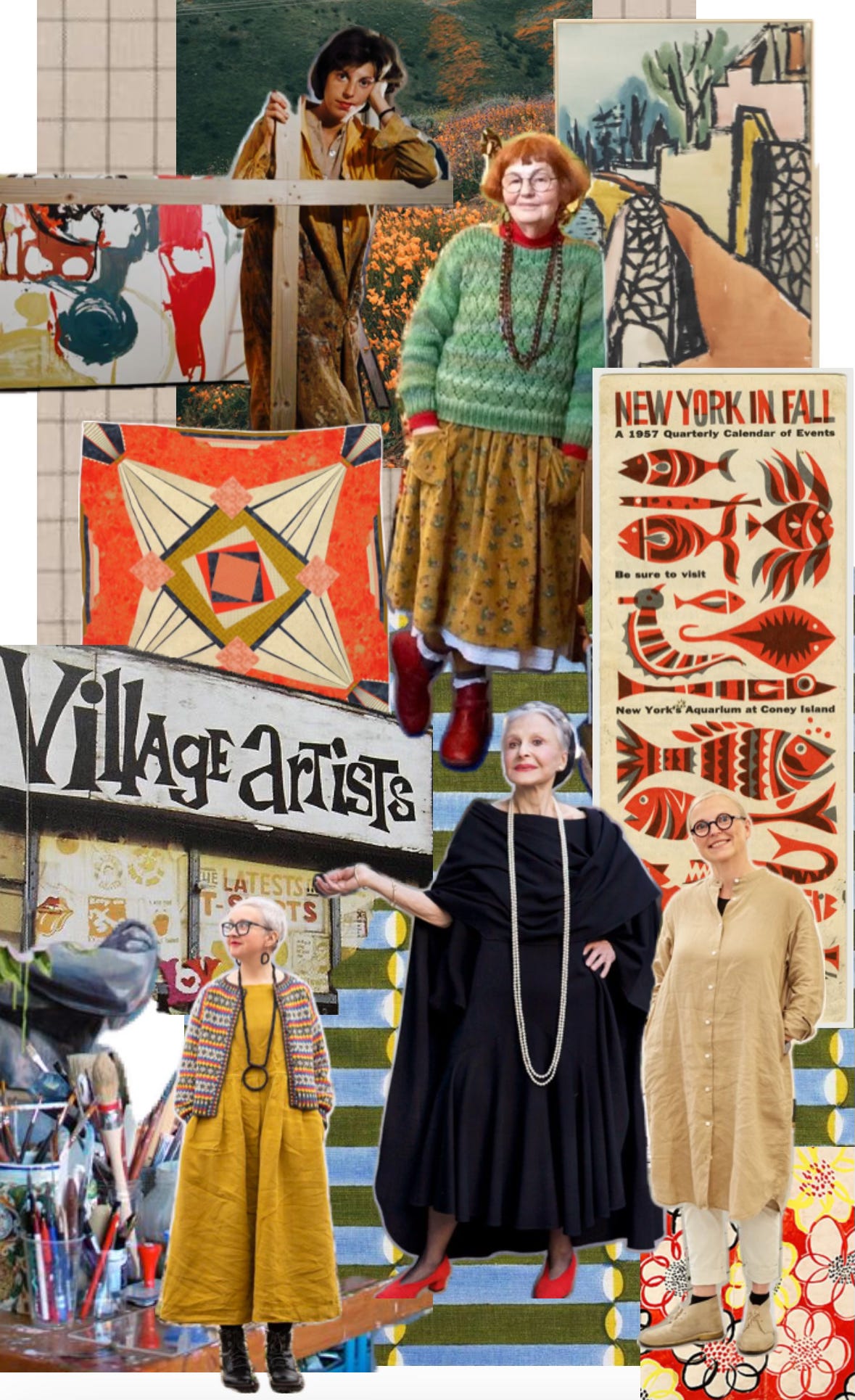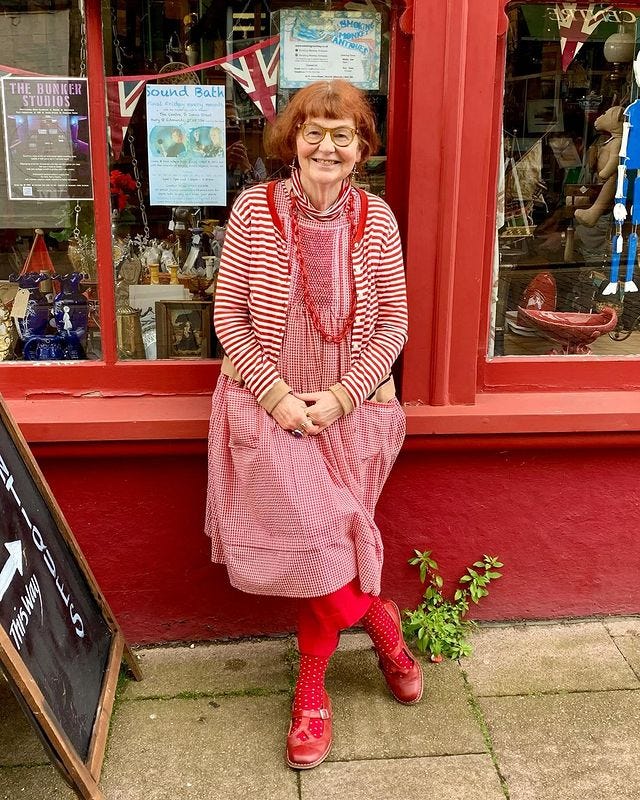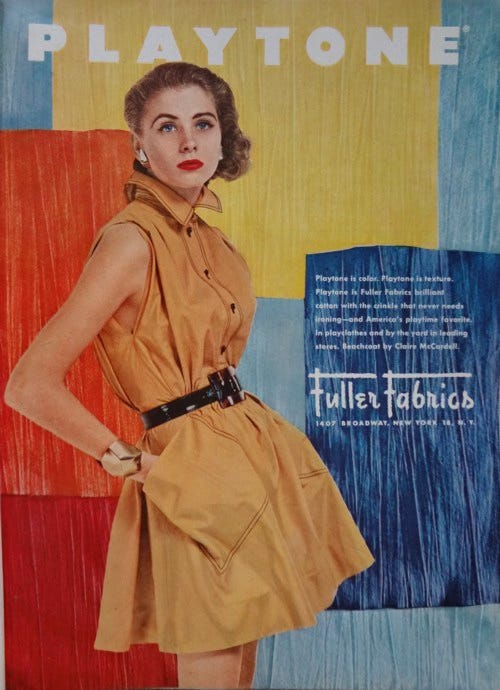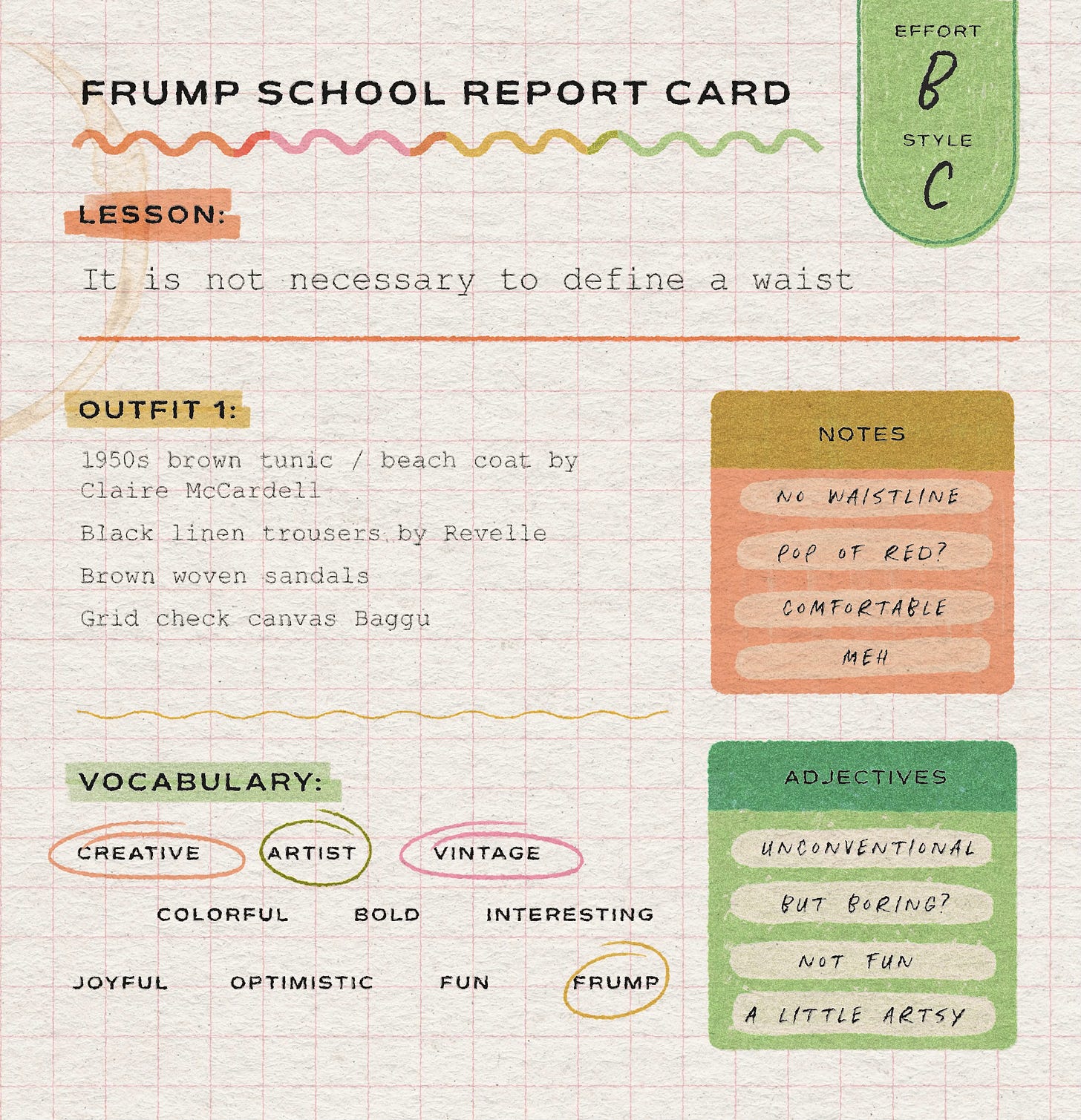Rebuilding a sense of style, part II
My first day of Frump School
So last time was maybe a bit serious, but now, we are entering a much more fun zone. When we wear clothes, we (like it or not) are communicating something to the world about who we are. Color, texture and shape can work together to tell a story about us. Of course, this doesn’t always need to be intentional—when I walk in the park or work at home or go to the garden center I definitely do not think or even care about what story I’m telling about myself. Nor is this always accessible; finding clothes at larger sizes that feel good and are affordable and are not fast fashion can be very difficult. But if you are interested in developing your own style, it’s helpful to have a few outfits1 that are intentional and do tell the story we want to tell, so let’s figure out how to find them.
First, let’s define what I mean when I say “frump.” I don’t consider it a denigrating descriptor, but rather an indication of not performing femininity in a way that prioritizes sexual attractiveness to men. In short, as Eisenberg writes,
“Frump is a way of being feminine. The way of Frump is not in terms of attractiveness but in terms of freedom, comfort, and self-delight. It can be observed in objects, structures, and people of any sex, but because it was born of the machine of patriarchy and male domination as a way to shame the feminine for failing to subscribe to [Sexy Adult Woman] values, it is a sensibility most fundamentally of and for the feminine.”
Frump is not flattering in that it does not pursue any attempt to make the body appear smaller or taller or more sexually available. It prioritizes comfort and utility. It does not try to contain, shape or smooth. It accepts you as you are and asks, Mary Oliver style, what it is you wish to do with your one wild and precious life?
In working as a designer and art director for the past 20 years, I have often found it useful to define personas for target customers or users, so I encourage you to do the same when defining your own style. See if you can define a clear idea of who you want to dress and feel like, and pick out three words you’d use to describe that person.
My Frump, my self-delight, feels like an art teacher in her 50s, living in the same rent-controlled, light-filled flat in the Village (or SF, like Midge’s apartment in Vertigo) she’s lived in for 30 years, with a big open studio filled with antiques and things picked up on travels; brushes and pastels semi-organized in mason jars and vintage pottery. She doesn’t iron. She has cats and no children. She loves bold colors, scarves, natural materials, easy things. Fun things that reflect her/me/us as someone creative, joyful, interesting. I feel like I’m kind of already there internally, I just want to see if we can get the exterior to match. What would her mood board look like?

After your mood board, finding diverse2 visual examples of your goal is immensely helpful, as it can sort of retrain your brain to what is normal. Include in your feeds and inspiration boards people who break your internal fashion rules and embody the feeling you’re going for.
Because in order to learn something new, you can’t just decide you don’t believe the old thing anymore. You have to replace the old thought pattern with a new one and consciously practice thinking and acting on it. If I want to stop thinking something like, you can only be stylish if (insert unhelpful rule), it helps to see others whose style I love that are actively dressing outside that rule. Try to include folks whose body type is similar to yours (this can be very difficult, see footnote 2, which I think is one reason I’m doing this at all).
Unexpected layers, fun colors, mixing textures and shapes! Both of these examples go against one of my previously firmly held fashion rules of defining a waist. When I was thin, I was absolutely certain that everyone looked better with a defined waist. But when my waistline vanished, I was faced with a frustrating challenge every time I tried to get dressed: define a waist and show your belly, or go shapeless and hide it. Both options seemed to internally amplify my shame, and hiding it became my default because it felt less bad. But seeing examples of waist-less style on folks of all sizes has helped retrain my brain to think, wow, I love their style so much and I could do that too, and if I could start seeing myself in that way, I might regain some confidence. Shoko Tatara, above, who puts together incredible fits that feel fun and true to her, articulated this in an interview on Cup of Jo last year:
“I’m very insecure about my body, especially my belly, but I’m trying to get more confident. I’m still nervous when taking photos, but seeing what my body looks like on a daily basis has helped me feel more comfortable. Years ago, on Cup of Jo, I read the advice that when you look in the mirror, you should view yourself as a friend. That helped me a lot.”
So we’ve got our school supplies: self-compassion, descriptive words to serve as visual guidance, and a mood board to help keep us on track. I’m only shopping my closet until I have a better sense of what direction my style will go in. It’s time to get dressed!
For my first day of Frump School, I did not go crazy with colors or patterns (I’m not sure I ever will), but I did want to challenge the defined waist rule and wear something I would not have considered in the before times: a dress/long tunic over pants.
Because I will probably always be interested in vintage, I’m looking for more ways to wear the things I truly love now that my body has changed. This Claire McCardell dress/tunic/top was probably meant to be belted and worn as a beach coat, like this:
Mine has seam pockets and the fabric is a bit heavier weight and not as full as this 1952 example, but the lack of buttons going all the way down and the seemingly original hem makes me pretty certain that this was always meant to be this short and worn over a swimsuit at the beach. When I first put this outfit on I wanted to belt it, but then I remembered the whole point of this experiment is to prioritize comfort and get myself used to seeing a fatter me without trying to trick the eye.
And yeah, I am not comfortable with this! The shame alarm bells going off in my head are loud! I have decided I do not get to photoshop/liquify my body or my neck because I know that if I do that, the image I see here will not match up with what I see in the mirror and I’ll be circumventing the entire point of this exercise. Also, that’s just kind of a shitty and dishonest thing to do!
So I have never been a big fan of the dresses over pants thing (ditto asymmetric hems and slips as dresses, 90s teen trauma? idk) and this was unexceptional. Like these pieces individually are great, but together it’s like chocolate and tomatoes or whatever and the place where this bisects me just feels wrong (I’m trying real hard not to use the word “flattering”). I think for my first day of Frump School I get a B for effort and a C for style. It just ended up being a kind of shapeless boring thing but I am posting it anyway for my new neural pathways. A pop of red would have helped (**makes note**) but I don’t think this is an outfit I’m going to repeat anyway.
How did we do?
I’m meeting some of my goals here, I get to be comfortable and shapeless and wear vintage and it does feel kind of like an artist smock, but it doesn’t feel fun and it doesn’t feel true to the original intention of the garment. I don’t think that’s always necessary, but for me the mismatch isn’t quite working. And that’s okay! We’re going to keep learning and trying new things. Onward!
Like really, no more than five or six. I shop almost exclusively secondhand because ethical fashion is expensive, and we generally just don’t need as much clothing as we buy, and I certainly don’t need as much as I used to buy.
Wow this is really hard! Like there are very stylish people who are fat and young, or thin and old, but apparently I can’t find any who are fat and old and also stylish?? Is it ok to be a fat style influencer only if you are also young or does the algorithm just not show them to me? Please send help.








Just want to say that I truly love this series and really appreciate you talking about it and sharing it. Much solidarity and hell yeah. 💚
I love the report card!
There is a fabric & sewing pattern company called Merchant & Mills whose aesthetic you might appreciate (@merchantandmills) and they use more diverse models than most in both size and age.
But generally speaking, it does seem that you are only allowed to be old if you are also thin, particularly if you have silver hair. Apparently the world can only accept one non-conformity at a time!